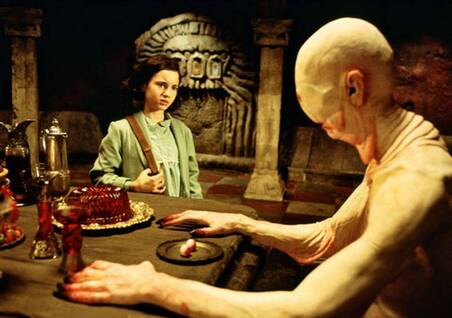A | A girl in Franco's Spain imagines herself as a princess in a dark fantasy kingdom. Directed by Guillermo del Toro Starring Ivana Baquero, Sergi Lopez, and Maribel Verdu Review by Jon Kissel |

Something a fascist wouldn’t find productive is storytelling, or at least the kind that isn’t buttressing the state and its values. No single person can be the main character when everything revolves around the state or the race, negating the old standby about everyone being the main character in their own story. The most important thing in Ofelia’s life is her mother, but a close second is books and the fairy tales contained within them. The possibility of a world with independent rules and values from the fascist one she lives in, combined with a refusal to believe that the most she can hope for is to make babies for a husband she’ll be lucky to tolerate, sends her into a fantasy where she’s integral. The distinction between Ofelia’s fantasy and Vidal’s reality isn’t as concrete as I wished it was and that blurriness detracts from the overall film. The film gains a level if the mandrake root doesn’t squeal in the fire and Ofelia’s mother (Ariadna Gil) doesn’t immediately decompensate as a result.
That said, there aren’t that many levels for Pan’s Labyrinth to add to its lofty position. The creature design that Del Toro is renowned for gets its most indelible workout here, starting with the faun (Doug Jones) and the toad and cresting with the pale man (also Jones), a triumph of detail that gets more terrifying with each new reveal. It’s striking enough sitting still at the banquet table, and then it puts its eyes into its hands, and then it raises its hands to its face. The junkie vampires in Blade II with their open jaws inspired countless horror monsters, but the pale man has never been duplicated.
Del Toro isn’t just flexing these imaginative muscles because he can. If the world that Ofelia imagines has that creature in it, what does that say about her reality? Both are incredibly dark, and both allow for the possibility that children will die unmemorialized deaths. Ofelia’s belief that she is the main character in her story doesn’t prevent her from being murdered. The film begins in media res with her dying moments, leaving her in the same position as the owners of one of the shoes piled up in the pale man’s dungeon. The film then traces the path that will lead to this moment, a path that existed for the shoe owners but that we aren’t privy to. A fascist worldview couldn’t be bothered with these stories, but a humanist one demands it. Pan’s Labyrinth acknowledges the brutality of the former while aspiring to the latter, and its clear-eyed perception of both is an even greater asset than the pale man.
Showing humanity in the face of brutality extends to characters who aren’t imagining themselves as secret princesses. A lot of time is spent with the rebels fighting against Vidal, and Del Toro gives them humanizing moments. An amputee asks for a brief moment for himself before the doctor (Alex Angulo) starts cutting, and the whole film takes a breath with him. The doctor himself insists on his own dignity until the end, choosing to walk away from, and therefore belittle, Vidal for as long as he can. Even the monstrous Vidal is keeping his own story to himself. The people around him have all heard his family legend about his soldier father demanding someone tell his son about the precise moment he died, but Vidal denies it because it places him outside of the anti-romantic fascist ideal. At the moment of his own death at the hands of the rebels, he can be honest with them and asks to be remembered by his infant son. Instead, they serve his values back to him, promising to never tell the baby his father’s name and thus turn him into the same kind of anonymous corpse that he’s littered Spain with.
Pan’s Labyrinth builds out one dying girl’s inner life in a period where a lot of girls and boys and adults were dying, and implicitly forces the viewer to consider all those other lives. Seventy-five million people or so died in the conflicts surrounding World War II, and, per Holocaust historian Timothy Snyder, the exercise is to reframe it as seventy-five million times one. Del Toro’s best film tries to do exactly that, to imagine all the wonder that a single mind contains and to mourn what’s lost when it ceases to exist. A-
 RSS Feed
RSS Feed